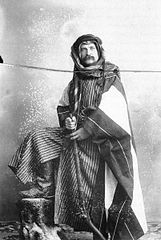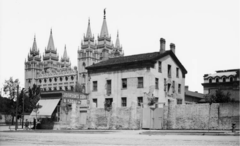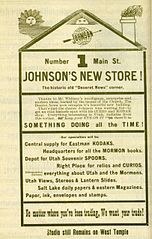« Photographie/Personnalités/J/Charles Ellis Johnson » : différence entre les versions
Page créée avec « {{Ph s Personnalités}} '''Charles Ellis''' « '''Charlie''' » '''Johnson''' (21 mars 1857 – 21 février 1926) était un photographe états-unien et mormon connu p... » |
|||
| Ligne 16 : | Ligne 16 : | ||
<gallery widths="240px" heights="240px"> |
<gallery widths="240px" heights="240px"> |
||
C. E. Johnson logo.jpg |
C. E. Johnson logo.jpg|Logo de C. E. Johnson |
||
Charles Ellis Johnson ca 1885.jpg |
Charles Ellis Johnson ca 1885.jpg|Charles Ellis Johnson ca 1885 |
||
Charles Ellis Johnson in costume.jpg |
Charles Ellis Johnson in costume.jpg|Charles Ellis Johnson en costume |
||
Charles Johnson untitled self-portrait.jpg |
Charles Johnson untitled self-portrait.jpg|Autoportrait |
||
Johnson's photo studio c 1910.png |
Johnson's photo studio c 1910.png|Le studio de Johnson vers 1910 |
||
Johnson's store advertisement.jpg |
Johnson's store advertisement.jpg|Publicité du magasin de Johnson |
||
Joseph Ellis Johnson's family.png |
Joseph Ellis Johnson's family.png|La famille de Joseph Ellis Johnson |
||
</gallery> |
</gallery> |
||
=== La carrière |
=== La carrière === |
||
===Career=== |
===Career=== |
||
In Salt Lake City, Johnson worked as a druggist for the [[ZCMI]].<ref name="SNAC"/> In 1889 he partnered with [[Parley P. Pratt]] to operate the Johnson-Pratt Drug Company.<ref name="SNAC"/><ref name="Wadsworth 1992"/>{{rp|271}} Johnson made and sold various family [[patent medicine]]s, including his "Valley Tan Remedies."<ref name="Wadsworth 1992"/>{{rp|288}} During the 1890s, he became involved in the [[American Star Bicycle]] craze by selling them and becoming vice president of Salt Lake's Social Wheel bicycle club.<ref name="Campbell 2016"/>{{rp|5–6}} |
In Salt Lake City, Johnson worked as a druggist for the [[ZCMI]].<ref name="SNAC"/> In 1889 he partnered with [[Parley P. Pratt]] to operate the Johnson-Pratt Drug Company.<ref name="SNAC"/><ref name="Wadsworth 1992"/>{{rp|271}} Johnson made and sold various family [[patent medicine]]s, including his "Valley Tan Remedies."<ref name="Wadsworth 1992"/>{{rp|288}} During the 1890s, he became involved in the [[American Star Bicycle]] craze by selling them and becoming vice president of Salt Lake's Social Wheel bicycle club.<ref name="Campbell 2016"/>{{rp|5–6}} |
||
Version du 5 mai 2017 à 22:32
| |||
|
plan du chapitre en cours
|
navigation rapide
Fabricants et marques de produits et de matériels Personnalités du monde de la photographie Éditeurs de cartes postales photographiques Thèmes ▪
Bibliographie
■ préface - SOMMAIRE COMPLET ■ notions fondamentales et conseils pour les débutants ■ aspects esthétiques, thèmes photographiques ■ références scientifiques ■ photométrie, colorimétrie, optique ■ appareils, objectifs, éclairage, accessoires, entretien ■ procédés chimiques ■ procédés numériques ■ caractéristiques physiques des images, densité, netteté ■ compléments techniques et pratiques ■ photographie et vie sociale, histoire, enseignement,institutions, droit... | ||
Charles Ellis « Charlie » Johnson (21 mars 1857 – 21 février 1926) était un photographe états-unien et mormon connu pour son travail dans l'Utah et autour du Monde. Il fut élevé à Saint-George, dans l'Utah, et s'intéressa à la botanique et au théâtre.
En exploitant une pharmacie à Salt Lake City, il a commencé à prendre su plaisir avec la photographie et a ouvert un studio photo. Il a photographié des acteurs et des actrices au Salt Lake Theatre, y compris des nus artistiques. Il a photographié des attractions de l'Utah et, en 1903, il a parcouru l'Empire ottoman pour prendre des photos pour l'Exposition mondiale de Saint-Louis en 1904. En 1917, Johnson s'installa à San Jose, Californie, où il continua à exploiter un studio photo.
Biographie
Les jeunes années
Le père de Charles Ellis Johnson, Joseph Ellis Johnson, a commencé à pratiquer la polygamie dans les années 1850 et a épousé sa troisième femme, Eliza Saunders, en 1856. Eliza a donné naissance à Charles le 21 mars 1857 à St. Louis, Missouri, après quoi ils ont vécu dans de petites colonies mormones au Nebraska. Charles et sa famille étaient membres de l'Eglise de Jésus-Christ des Saints des Derniers Jours. En 1860 Charles, sa mère et quatre de ses cousins orphelins ont traversé les plaines pour s'établir à Salt Lake City. L'année suivante, Joseph et ses deux autres femmes se sont joints à eux. Joseph a déclaré qu'il « n'a pas souhaité vivre en ville » et a acheté des terres près de Payson, Utah et Santaquin, Utah, et s'est installé là-bas. En 1865, la famille Johnson déménagea à St. George, Utah. Charles a appris à écrire et à utiliser des presses d'imprimerie. Il a travaillé avec le botaniste C. C. Parry pour faire l'inventaire des plantes du sud de l'Utah. Il a également travaillé pour le botaniste et l'archéologue Edward Palmer en l'aidant à creuser des tumulus indiens et à collecter divers spécimens. Charles a appris plusieurs langues amérindiennes pour parler aux membres de la tribu locale. Il s'est également intéressé au théâtre pendant cette période. Charles n'a pas eu d'éducation formelle.
Brigham Young avait une résidence d'hiver à St. George, adjacente à la maison de Johnson. En grandissant, Charles connut la famille Young. Une des filles de Brigham, Susa Amelia Young, était membre de la troupe théâtrale de Charles. Susa a fait en sorte que Charles puisse sortir avec sa demi-soeur, Ruth Young. Charles et Ruth ont été mariés au temple de St. George le 28 janvier 1878. Ils eurent trois enfants, deux garçons et une fille. En 1882, Charles Johnson, son épouse et son enfant se sont installés dans une petite maison au centre de Salt Lake City. Ruth a finalement quitté Charles, qui a ensuite demandé le divorce en 1887.
-
Logo de C. E. Johnson
-
Charles Ellis Johnson ca 1885
-
Charles Ellis Johnson en costume
-
Autoportrait
-
Le studio de Johnson vers 1910
-
Publicité du magasin de Johnson
-
La famille de Joseph Ellis Johnson
La carrière
Career
In Salt Lake City, Johnson worked as a druggist for the ZCMI.[1] In 1889 he partnered with Parley P. Pratt to operate the Johnson-Pratt Drug Company.[1][2]Modèle:Rp Johnson made and sold various family patent medicines, including his "Valley Tan Remedies."[2]Modèle:Rp During the 1890s, he became involved in the American Star Bicycle craze by selling them and becoming vice president of Salt Lake's Social Wheel bicycle club.[3]Modèle:Rp

After dabbling in photography, Johnson joined Hyrum Sainsbury to open a photographic studio.[2]Modèle:Rp Johnson soon became the undesignated "official photographer" of the Salt Lake City Theater.[2]Modèle:Rp He was the official Utah correspondent for the New York Dramatic Mirror.[4]Modèle:Rp He started taking risqué photographs, likely because of his work with burlesque theater, and often incorporated elements of orientalism.[4]Modèle:Rp He took glamour photographs of actresses, artistic nudes, and risqué stereoviews.[1] He was the only Mormon photographer during his time who sold risqué photographs.[4]Modèle:Rp
In the 1890s, Johnson became the unofficial photographer for the LDS Church. He photographed the dedication of the Salt Lake Temple and LDS Church leaders. He traveled with the Mormon Tabernacle Choir to the Chicago World's Fair in 1893, and visited San Francisco in 1896.[4]Modèle:Rp Johnson advertised his studio as an "Information Bureau [for] everything about Utah and the Mormons."[5]Modèle:Rp He became a "social Mormon" by maintaining the appearance of Mormonism while eventually dissociating himself from the LDS Church.[4]Modèle:Rp While Johnson spent most of his time in Utah, he also traveled extensively, taking photographs in New York, Paris, and London. His trademark phrase was "You see Johnson all over the World."[3]Modèle:Rp

In 1897 Johnson photographed and befriended the actress Lydia Mary Olive Von Finkelstein Mamreov Mountford at the Salt Lake Theater. Mountford returned to Utah in 1903 and hired Johnson as a photographer for her Jerusalem exhibit at the St. Louis World's Fair. They traveled through Palestine and Jerusalem in the Ottoman Empire taking pictures of the scenery. At the World Fair in 1904, Johnson and Mountford found that the exhibit's management had repudiated Mountford's contract. Johnson tried with little success to market his photos in St. Louis.[2]Modèle:Rp
After returning from his tour, Johnson formed an "unconventional relationship" with businesswoman Minnie B. Ridley and hired her to help him with his businesses in Salt Lake City.[4]Modèle:Rp In 1917 he liquidated his assets and moved to San Jose, California to live with the Ridley family, where he operated another photographic studio. He died from a heart seizure on February 21, 1926 and was buried in Oak Hill Memorial Park.[2]Modèle:Rp
References
- ↑ 1,0 1,1 et 1,2 « Johnson, Charles Ellis, 1857–1926 », Social Networks and Archival Context (consulté le 4 janvier 2017)
- ↑ 2,0 2,1 2,2 2,3 2,4 et 2,5 Nelson B. Wadsworth, Set in Stone, Fixed in Glass: The Great Mormon Temple and its Photographers, Salt Lake City, Signature Books, , 271–311 p. (ISBN 1560850248, lire en ligne), « Charles Ellis Johnson: 'Every Point of Interest' »
- ↑ 3,0 et 3,1 Mary Campbell, Charles Ellis Johnson and the Erotic Mormon Image, Chicago, IL, University of Chicago Press, (ISBN 9780226410173, lire en ligne)
- ↑ 4,0 4,1 4,2 4,3 4,4 et 4,5 Daniel Davis, « 'Appreciating a Pretty Shoulder': The Risqué Photographs of Charles Ellis Johnson », dans Utah Historical Quarterly, vol. 74, 2006, p. 131–146 [texte intégral]
- ↑ Mary Campbell, Sensational Religion: Sensory Cultures in Material Practice, Yale University Press, , 261–274 p. (ISBN 9780300187359), « Praying for Grace: Charles Ellis Johnson's Synesthetic Skin »








